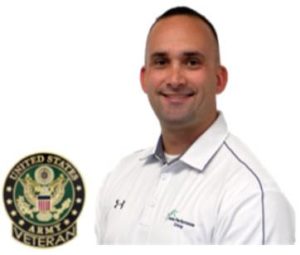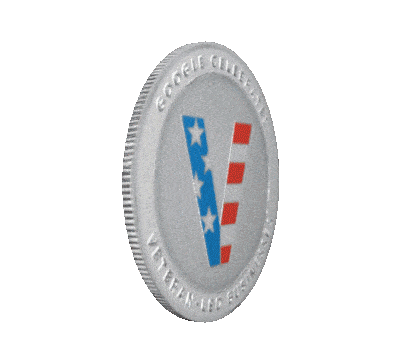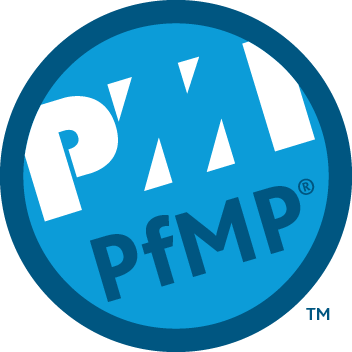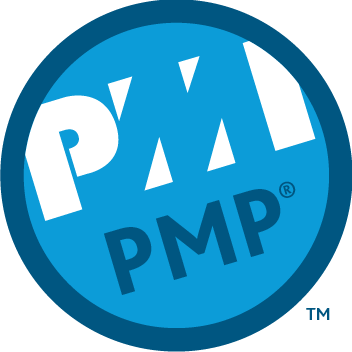Insulated Concrete Form Construction – Passive Survivability
Electrical Grid Reliability Today
In 2020, the United States Energy Information Administration (EIA) reported, U.S. electricity customers experienced more electrical service interruptions than any other time since the agency began collecting data on reliability. 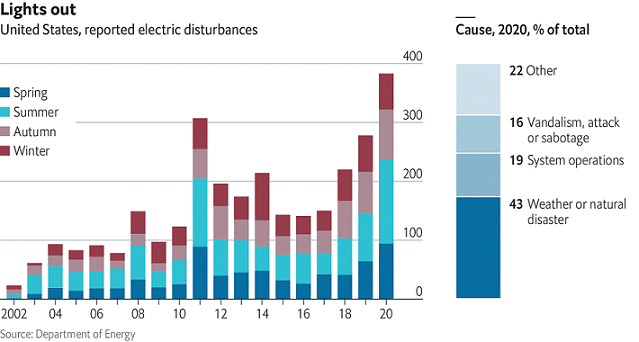
During the cold of winter or heat of the summer, loss of electricity and essential services could pose life safety concerns to vulnerable populations such as the elderly, young children, and medically comprised individuals. In addition to planned power outages, unusually high peak demand, or interruptions to utility distribution, can lead to unexpected brown outs. A brown-out causes a drop in delivered voltage which often causes damage to sensitive electronics, and connected electrical devices, especially electric motors.
Are We Prepared for a Future with More Power Outages?
Numerous factors contribute to power outages. Some are more prevalent in the United States and affect the frequency, and severity of service interruptions. Although, utility-scale wind and solar projects continue to come online, there are several challenges to U.S. electrical infrastructure. A confluence of risks events is expected to increase the prevalence and duration of electrical power outages moving forward.
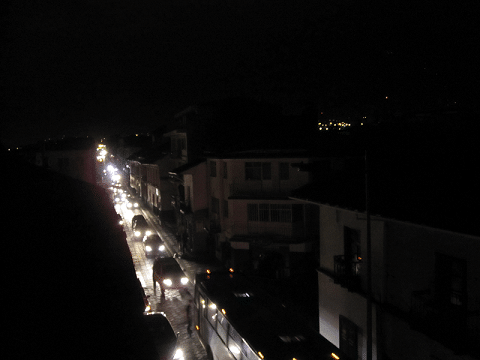
Second, because both wind and solar are dependent on dynamic and changing weather conditions, the Energy Information Administration finds renewable electricity generation can only be used for intermittent capacity purposes. This limits the use of renewable electricity to supplementation of base load capacity, and temporarily shifting peak load generation from fossil fuels to renewables when weather permits. Meaning, even if renewable energy generation could meet total U.S. demand, during periods of darkness or low wind, delivery of electricity would be sporadic at best, and unreliable at worst.
Third, a lack of investment in new base load electrical power production constrains supply at the same time demand is rising. More than 80% of all domestic electricity production is sourced from nuclear, natural gas, and coal-fired power plants. These sources create the foundation of U.S. base and intermediate load generation. Base load generation refers to electric power supplied on a continuous basis and a constant rate to meet all, or part, of the minimum demand on the electric grid. Federal environmental standards have effectively banned new nuclear, and coal-fired electric generation plants. New energy standards and regulations in many states are now requiring the complete phase-out of coal-fired electrical generation, further shuttering existing base power production capacity. The EIA reports 28% of coal fired electric plants, representing 59 billion watts of electricity production, are planned for retirement by 2035. These planned closures are in addition to a 30% reduction in generating capacity already since 2010. Many of these generating facilities provide base load capacity, and were constructed in the 1980s and 1990s with available service life remaining.
Fourth, annual electricity demand is expected to grow at a historically unprecedented pace. A study by National Renewable Energy Laboratory (NREL), identified two significant drivers of accelerated growth in electricity demand. Electrification of transportation, and transitioning home heating, and hot water production from fossil fuels to electric heat pump technology. NREL provides three demand growth scenarios. Even in the base case scenario, electricity demand will more than double by 2050. The challenge is not just with total electricity demand, but shifts in peak loading of the electric grid. Without growth in reliable base load generation capacity, mismatches in demand and supply will occur. For instance, night time charging of EVs, or cold winter nighttime temperatures could create peak loads exactly when renewable solar or wind capacity is at the lowest.
Finally, in addition to supply constraints and demand growth, research by Reliability Engineering and System Safety Journal found U.S. electrical infrastructure historically has been most vulnerable to weather related events. Such events involve high winds, from strong thunderstorms, tornados, and hurricanes; or extreme weather, such as snow and ice storms in the winter and heat waves and droughts during the summer. The U.S. Global Change Research Program predicts climate change will increase both the frequency and severity of storms, specifically higher wind events, heavier rain storms, and more days per year above 90oF. Each event increases the risk of power outages. Locations serviced with overhead power distribution lines or heavy tree growth are most vulnerable, although cascading outages can impact hardened distribution networks as well. In addition to weather related vulnerabilities, the President’s National Infrastructure Advisory Council (NIAC) prepared a report studying catastrophic power outages. 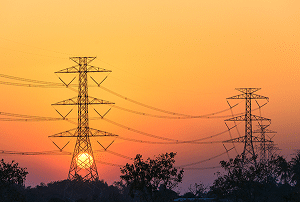
Taken together, the risk profile for more frequent and longer lasting power outages appears highly likely. At best, future electricity service and reliability are uncertain. Clearly, building better homes capable of providing both comfort and safety during power outages are critical. That is the concept of passive survivability. Insulated concrete form construction delivers more thermally stable indoor temperatures during normal operation, and considerably longer safe indoor temperatures during power outages.
Insulated Concrete Form Homes – A Case for Passive Survivability
What is passive survivability, and how do we define the concept? Passive survivability describes the ability of a home to maintain a safe indoor temperature for occupants during loss of essential services, such as electricity or gas. The more hours of safety a home can deliver passively, the longer occupants may shelter in place, without heating or air-conditioning. Homes delivering more hours of safety better protect occupants during anticipated future power outages. To keep housing costs as low as possible, the majority of American homes, both existing housing stock and new construction, are built to minimum code standards, using the cheapest building materials possible. One consequence of that decision, are homes lose heat faster in the winter, and gain heat quicker in the summer, thereby decreasing the hours of safety a home can provide.
There are numerous cases of power outages causing loss of life from occupant exposure to extreme temperatures, both hot and cold. 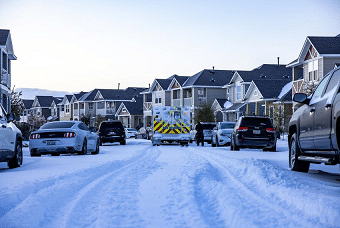
Several academic studies and scientific research papers forecast an increase in the frequency and severity of both winter storms, and summer heat waves. More frequent storms of growing intensity are likely to increase power outages causing a loss of heating in the winter and air-conditioning in the summer. Because of the extreme weather, homes offering little passive survivability will subject occupants to increasingly dangerous levels of cold and heat. Already today, the United States experiences more than 65,000 heat related emergency room visits per year, and more than 1,300 deaths. The National Resources Defense Council (NRDC) predicts by 2040, the United States may suffer more than 13,000 annual heat related deaths, a tenfold increase from today.
Individuals’ tolerance to extreme temperatures varies with age, physical health, preexisting medical conditions, and duration of exposure. Because of those factors, clinicians face a difficult challenge precisely setting safe minimum or maximum indoor temperatures to prevent adverse health effects. Medical research finds young children and the elderly are especially sensitive to extreme temperatures and generally classified as vulnerable populations. Given that, the United States National Institute of Health (NIH) recommends a minimum 64oF indoor temperature for vulnerable populations. Referencing NIH table 5.1 on high indoor temperatures, NIH recommends a maximum indoor temperature of 82.4oF to minimize heat-related health effects.
Insulated Concrete Form Construction Delivers More Hours of Safety
Elimination of thermal bridging, higher insulation levels, and enhanced air-sealing each individually improve hours of safety, but when taken together, deliver astonishingly better results. Insulated concrete form walls and foundations combine all three functions offering prospective buyers a superior product and safer home.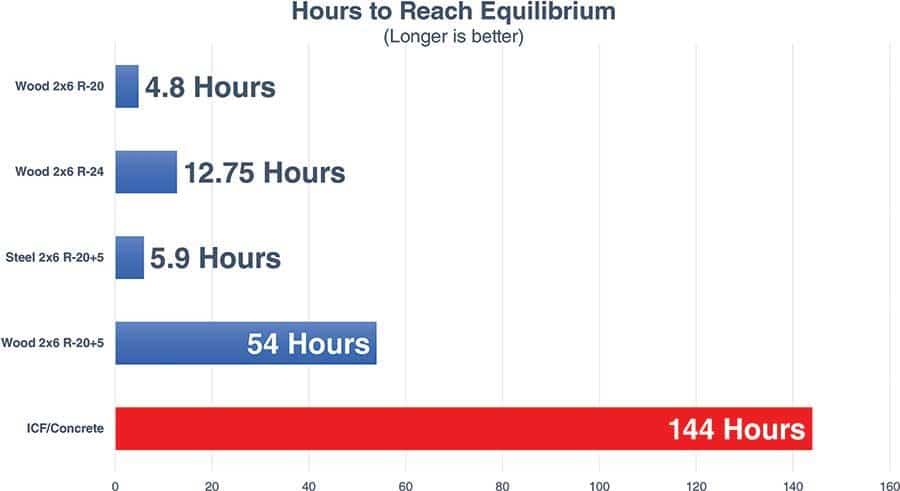
Specifically, ICF walls offered 144 hours before reaching equilibrium with the exterior as opposed to 4.8 hours for standard 2×6 wood walls with traditional cavity insulation. The additional hours of safety delivered by insulated concrete form walls may be the difference between life and death for vulnerable populations. Moving forward, hours of safety should become a factor in purchasing decisions and new construction budget priorities.
Home Performance ICF Construction in Kansas City
Considering building a new home, shop, or out-building? Interested in a storm resilient structure? Looking for a long-term high-performing structure? Consider hiring a full-service construction firm specializing in insulated concrete form building. Careful selection of an experienced ICF builder can offer decades of safe, comfortable, low-cost living.
At Home Performance Group, we continue to invest in technical training so we can correctly design, specify, size, and install ICF foundation and wall systems. We have performed numerous insulated concrete form projects for our clients.
If you are interested in a no-cost in-home consultation, schedule with a Solutions Advisor today.

Article by Larry L. Motley Jr., 1 September 2023
Larry is a graduate of both Wentworth Military Academy and Missouri Western State University earning a double bachelor’s degree in Economics and Finance. Additionally, he maintains six professional tradesman licenses in two states and advanced credentialing in green technology, project and program management, and process improvement. Larry is a three-time combat veteran having served in Operation Iraqi Freedom, Operation New Dawn, and Operation Inherent Resolve. He continues to serve through a value-based building science company focused on providing clients the best design, highest quality installation, and most honest repair services in the community.


Featured Service Areas:
| Missouri | Kansas | ||||
|---|---|---|---|---|---|
|
Belton Blue Springs Cameron Excelsior Springs Gladstone Holt |
Independence Kansas City Kearney Lathrop Lawson Lee's Summit |
Liberty North Kansas City Parkville Platte City Plattsburg Polo |
Raytown Riverside Smithville Sugar Creek Weston |
Kansas City Lansing Leavenworth Leawood Lenexa |
Merriam Mission Mission Hills Praire Village Shawnee |



